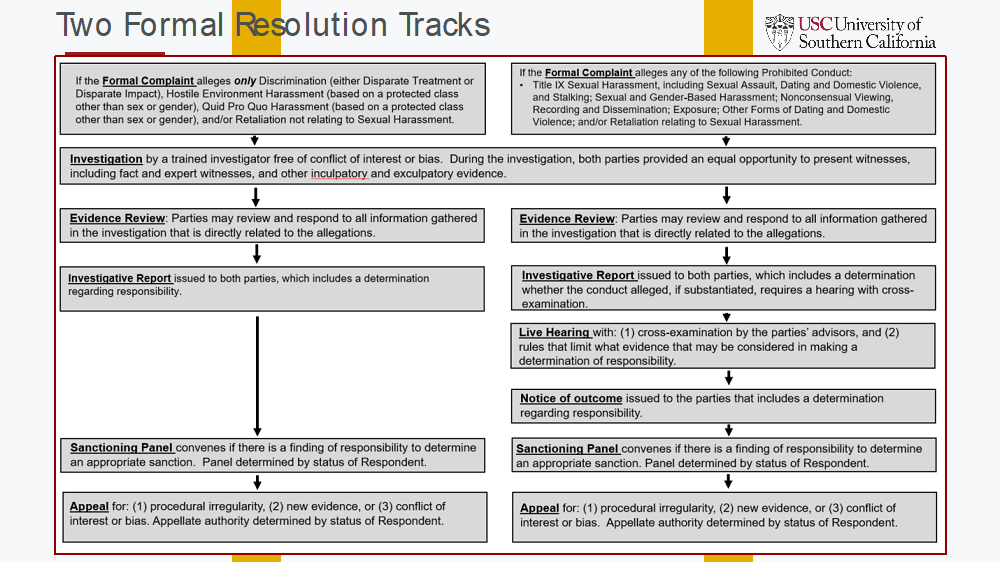EEO-TIX Resolution Processes
EEO-TIX has two separate Resolution Processes (i.e., grievance procedures), as described below, that may apply depending upon the nature of the alleged Prohibited Conduct under the University’s Policy on Prohibited Discrimination, Harassment and Retaliation. The key difference is that, under the Resolution Process for Sexual Misconduct, a live hearing is required and the decision as to whether the Policy has been violated is made by an external, trained Hearing Officer. Read more about these processes below.

Two Formal Resolution Tracks
Track One:
If the Formal Complaint alleges only Discrimination (either Disparate Treatment or Disparate Impact), Hostile Environment Harassment (based on a protected class other than sex or gender), Quid Pro Quo Harassment (based on a protected class other than sex or gender), and/or Retaliation not relating to Sexual Harassment.
Investigation by a trained investigator free of conflict of interest or bias. During the investigation both parties are provided an equal opportunity to present witnesses, including fact and expert witnesses, and other inculpatory and exculpatory evidence.
Evidence Review: Parties may review and respond to all information gathered in the investigation that is directly related to the allegations.
Investigative Report issued to both parties, which includes a determination regarding responsibility.
Sanctioning Panel convenes if there is a finding of responsibility to determine an appropriate sanction. Panel determined by status of Respondent.
Appeal for: (1) procedural irregularity, (2) new evidence, or (3) conflict of interest or bias. Appellate authority determined by status of Respondent.
Track Two:
If the Formal Complaint alleges any of the following Prohibited Conduct:
- Title IX Sexual Harassment, including Sexual Assault, Dating and Domestic Violence, and Stalking; Sexual and Gender-Based Harassment; Nonconsensual Viewing, Recording and Dissemination; Exposure; Other Forms of Dating and Domestic Violence; and/or Retaliation relating to Sexual Harassment.
Investigation by a trained investigator free of conflict of interest or bias. During the investigation both parties provided an equal opportunity to present witnesses, including fact and expert witnesses, and other inculpatory and exculpatory evidence.
Evidence Review: Parties may review and respond to all information gathered in the investigation that is directly related to the allegations.
Investigative Report issued to both parties, which includes a determination whether the conduct alleged, if substantiated, requires a hearing with cross-examination.
Live Hearing with: (1) cross-examination by the parties’ advisors (to the extent required by federal law), and (2) rules that limit what evidence that may be considered in making a determination of responsibility.
Notice of Outcome issued to the parties with a determination of responsibility.
Sanctioning Panel convenes if there is a finding of responsibility to determine an appropriate sanction. Panel determined by status of Respondent.
Appeal for: (1) procedural irregularity, (2) new evidence, or (3) conflict of interest or bias. Appellate authority determined by status of Respondent.